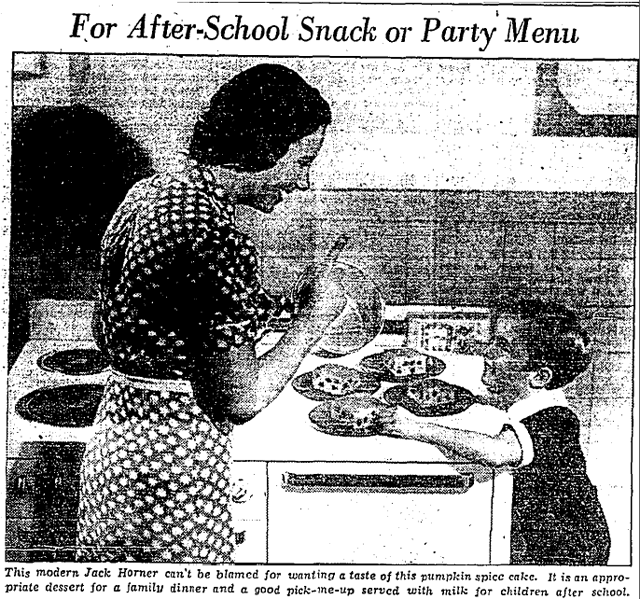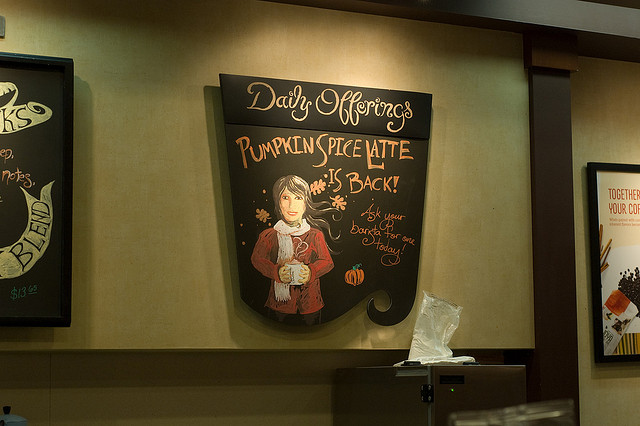The Dark And Murky History Of Pumpkin Spice
By Melissa McEwen in Food on Oct 31, 2014 7:15PM
Long before pumpkin spice became the punchline of jokes involving the “basic bitch” stereotype, it was a homey and innocent piece of Americana. How did it go from invoking nostalgia of autumn and family dinners to causing eye rolls? We went through old newspaper archives to try to find out what happened.
These days pumpkin spice foods and drinks, despite the name, rarely involves actual pumpkin. The vegetable’s presence comes from the fact that these are spices we have associated with pumpkin cooking for a long time. Perhaps the first reference in American cookbooks is in American Cookery by Amelia Simmons, an American orphan, which flavors what was then called a “pompkin” with molasses, allspice and ginger. Back then those were just spices, so when did the blend start being called pumpkin spice?

One of the earliest references to this type of blend as “pumpkin spice” is in a hilariously earnest recipe for “Pumpkin spice cakes” posted in the Washington Post in 1936. Titled “Spice Cake Of Pumpkin Newest Dish: Delicacy Tempting to All Appetites and Easy to Prepare. Ideal Dessert for Family Dinner, Healthful for Children,” it claims pumpkin is native to the “Levant” (in reality, Pumpkins, like other squash, are native to North America) mainly consumed by the “Italian peasantry.” Pumpkin sure has come a long way. But even then, a pumpkin spice dessert still seemed to always contain pumpkin.
The divergence probably came when spice companies like McCormick started bundling common spices used in pumpkin pie as "pumpkin pie spice" in the 1950s and then simply as “pumpkin spice” in the 1960s for people too lazy to measure out their own “Cinnamon, Ginger, Nutmeg, Allspice, And Sulfiting Agents.” Soon enough lazy cooks were using it to flavor all kinds of dishes normally spiced similarly to pumpkin pie, such as a “Cream of Sweet Potato Soup” published in The Orlando Sentinel in 1995.
It also shows up in ads for textiles as a color and in The Santa Fe New Mexican in 1995 in an article about a shop called wildCHASE offering “pumpkin spice” candles. In “Waxing euphoric about a wick-ed obsession,” Liz Stevens of The Times Union in Albany, New York fretted about the flavored candles— “Are we becoming a nation of cinnamon-apple and pumpkin-spice addicts?” Sadly, her worries came true.
1996 brings the first reference we can find to pumpkin spice coffee, the beginning of pumpkin spice’s downfall. “Roasters hope profits are brewing,” describes Home Roast Coffee near Tampa, Florida brewing up “pumpkin spice” beans. By 1998, it had spread to other cities like Las Vegas, where it was offered at The Whole Bean, and Fasig's in Allentown, Pennsylvania. “Mary Ann Schwoyer and her friends sat at a comfortable table in TJ's Cafe, in the new TJ Bart's Superstore in Hometown, Schuylkill County, licking Breyer's butter pecan ice cream cones between sips of Fasig's Pumpkin Spice coffee. It's a combination that can't be savored anywhere else— yet” writes Chris Parker in The Morning Call.
But that was soon to change. Pumpkin spice coffee spread across America’s small coffee shops surely, but slowly. By the early 2000s, some evil genius figured out that it sold well as a latte with plenty of cream and sugar. An early reference in a newspaper is “Springs coffee shops offer something to fit almost everyone's taste” in the Colorado Springs Gazette in January 11, 2002, which describes Purple Mountain Coffee in Colorado serving up a “pumpkin pie latte.”
The spread was complete in 2004 when Starbucks introduced their Pumpkin Spice Latte nationwide, amping up the beverage to pose it for domination with even more sugar, food coloring, and god knows what else.
Nation's Restaurant News reported that sales at Starbucks stores rose 11 percent that year. Pumpkin spice had completed its transformation from just a melange of spices assorted with pumpkin desserts to a liquid mass-market luxury good. By the late 2000s, it was already a stereotype, consumed by people bedecked in other mass-market luxury goods like Uggs and Northface Jackets.
What once was a blend of spices used to disguise the fact that pumpkin is really kind of bland has become synonymous with pumpkin itself and bland people. At this point the whole thing is so out of control that foods with the "pumpkin spice" blend are now just being called pumpkin despite the fact many of them don't contain pumpkin at all.

